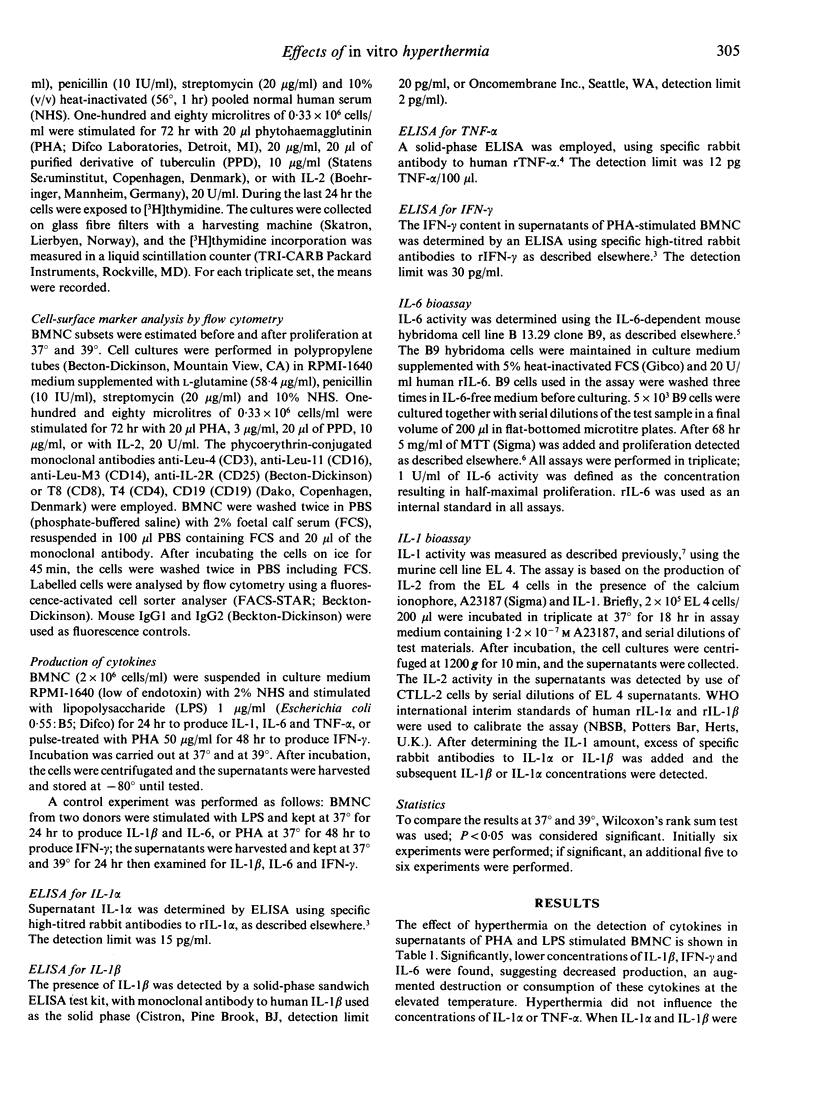Abstract
The role of endogenously mediated fever and exogenous hyperthermia as modulators of immune functions remains poorly understood. It is known that fever is mediated by several cytokines, including interleukin-1 alpha and interleukin-1 beta (IL-1 alpha and IL-1 beta), interleukin-6 (IL-6), tumour necrosis factor-alpha (TNF-alpha) and the interferons. The present communication examines the effect of exogenous hyperthermia on the detection of these cytokines and shows the suppressive effect of elevated temperature (39 degrees) on the amount of IL-1 beta, IL-6 and IFN-gamma (P less than 0.001) but not on IL-1 alpha and TNF-alpha concentrations. It is suggested that a negative feedback mechanism exists between temperature and the production of some of the molecules involved in the mediation of fever. It is known that hyperthermia increases the proliferative response of lymphocytes. We found a twofold increase in [3H]thymidine incorporation at 39 degrees compared to 37 degrees. The distribution of cells expressing CD3, CD4, CD8, CD14, CD16, CD19 and CD25 markers was the same at 37 degrees and 39 degrees.
Full text
PDF




Selected References
These references are in PubMed. This may not be the complete list of references from this article.
- Aarden L. A., De Groot E. R., Schaap O. L., Lansdorp P. M. Production of hybridoma growth factor by human monocytes. Eur J Immunol. 1987 Oct;17(10):1411–1416. doi: 10.1002/eji.1830171004. [DOI] [PubMed] [Google Scholar]
- Ashman R. B., Nahmias A. J. Enhancement of human lymphocyte responses to phytomitogens in vitro by incubation at elevated temperatures. Clin Exp Immunol. 1977 Sep;29(3):464–467. [PMC free article] [PubMed] [Google Scholar]
- Bendtzen K. Interleukin 1, interleukin 6 and tumor necrosis factor in infection, inflammation and immunity. Immunol Lett. 1988 Nov;19(3):183–191. doi: 10.1016/0165-2478(88)90141-1. [DOI] [PubMed] [Google Scholar]
- Dinarello C. A., Cannon J. G., Wolff S. M. New concepts on the pathogenesis of fever. Rev Infect Dis. 1988 Jan-Feb;10(1):168–189. doi: 10.1093/clinids/10.1.168. [DOI] [PubMed] [Google Scholar]
- Dinarello C. A., Dempsey R. A., Allegretta M., LoPreste G., Dainiak N., Parkinson D. R., Mier J. W. Inhibitory effects of elevated temperature on human cytokine production and natural killer activity. Cancer Res. 1986 Dec;46(12 Pt 1):6236–6241. [PubMed] [Google Scholar]
- Dinarello C. A. Interleukin-1. Rev Infect Dis. 1984 Jan-Feb;6(1):51–95. doi: 10.1093/clinids/6.1.51. [DOI] [PubMed] [Google Scholar]
- Duff G. W., Durum S. K. Fever and immunoregulation: hyperthermia, interleukins 1 and 2, and T-cell proliferation. Yale J Biol Med. 1982 Sep-Dec;55(5-6):437–442. [PMC free article] [PubMed] [Google Scholar]
- Fomsgaard A., Worsaae H., Bendtzen K. Detection of tumour necrosis factor from lipopolysaccharide-stimulated human mononuclear cells by enzyme-linked immunosorbent assay and cytotoxicity bioassay. Scand J Immunol. 1988 Feb;27(2):143–147. doi: 10.1111/j.1365-3083.1988.tb02332.x. [DOI] [PubMed] [Google Scholar]
- Hansen M. B., Nielsen S. E., Berg K. Re-examination and further development of a precise and rapid dye method for measuring cell growth/cell kill. J Immunol Methods. 1989 May 12;119(2):203–210. doi: 10.1016/0022-1759(89)90397-9. [DOI] [PubMed] [Google Scholar]
- Kappel M., Stadeager C., Tvede N., Galbo H., Pedersen B. K. Effects of in vivo hyperthermia on natural killer cell activity, in vitro proliferative responses and blood mononuclear cell subpopulations. Clin Exp Immunol. 1991 Apr;84(1):175–180. doi: 10.1111/j.1365-2249.1991.tb08144.x. [DOI] [PMC free article] [PubMed] [Google Scholar]
- Smith J. B., Knowlton R. P., Agarwal S. S. Human lymphocyte responses are enhanced by culture at 40 degrees C. J Immunol. 1978 Aug;121(2):691–694. [PubMed] [Google Scholar]
- Svenson M., Bendtzen K. Inhibitor of interleukin 1 in normal human urine. Different effects on mouse thymocytes and on a murine T-cell line. Scand J Immunol. 1988 May;27(5):593–599. doi: 10.1111/j.1365-3083.1988.tb02387.x. [DOI] [PubMed] [Google Scholar]


